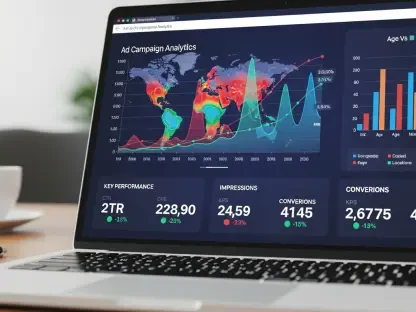In the fast-evolving world of digital advertising, staying ahead of ad fraud is a constant challenge for marketers and publishers alike. Today, we’re thrilled to sit down with Anastasia Braitsik, a global leader in SEO, content marketing, and data analytics, whose expertise in digital marketing offers invaluable insights into cutting-edge solutions for invalid traffic detection. In this interview, we’ll explore innovative approaches to identifying and mitigating fraud in real time, the impact on brand performance and publisher reputation, and the future of automation in the ad space. Let’s dive into how technology is reshaping the fight against ad fraud.
Can you explain what makes page-level detection so critical in the fight against invalid traffic, and how it addresses shortcomings in traditional methods?
Absolutely. Page-level detection focuses on the crucial moment between a click and user interaction, which has often been a blind spot for digital marketers. Traditional methods like pre-bid filters catch fraud before an ad is served, and post-campaign audits validate data after the fact, but they miss what happens when a user—or a bot—lands on a page. By analyzing behavior right at that point, we can spot suspicious activity before it skews metrics like engagement or conversions. It’s a game-changer because it closes that gap, giving us a clearer picture of what’s really happening.
How does real-time analysis at the page level work to identify invalid traffic as soon as a page loads?
It’s all about speed and precision. The technology uses a lightweight tag that integrates seamlessly into a webpage without slowing down the user experience. As soon as the page loads, it captures signals—like interaction patterns or anomalies—in milliseconds. These signals are then run through hundreds of algorithms and predictive models to classify whether the activity is human or invalid. The real-time aspect means we’re not waiting for a report days later; we’re catching bots and fake interactions the moment they happen.
What are some of the key advantages for brands and marketers when they have this kind of immediate visibility into invalid traffic?
The benefits are twofold: protection and optimization. First, real-time visibility protects revenue by stopping fraudulent activity from inflating costs or distorting performance data. If you’re not wasting budget on bots, you’re already ahead. Second, it improves campaign performance by ensuring you’re targeting genuine audiences. With detailed analytics breaking down traffic by source, campaign, or device, marketers can pinpoint what’s working and what’s not, refining their strategies on the fly to maximize ROI.
Can you elaborate on the mitigation strategies available once invalid traffic is detected on a page?
Certainly. Once invalid traffic is flagged, the system empowers brands and publishers to take immediate action. For instance, a brand might decide not to count a form submission if it’s deemed fraudulent, preserving the integrity of their data. A publisher could choose not to serve an ad to a bot, saving impressions for real users. The key here is control—having the ability to make these decisions in real time means you’re not just reacting to fraud after the damage is done, but actively preventing its impact.
How does this kind of technology specifically help publishers improve their inventory and reputation?
For publishers, invalid traffic can tarnish their domain’s reputation, making advertisers wary of partnering with them. By identifying the source of bad traffic, publishers can cut ties with problematic sources and focus on quality traffic. This not only cleans up their inventory but also boosts the value of their domain. Cleaner inventory builds trust with advertisers, showing them that their budgets won’t be wasted on bots. It’s about creating a virtuous cycle of quality and credibility in the ecosystem.
Looking ahead, how do you see the role of automation and AI shaping the classification of traffic in digital advertising?
We’re entering a fascinating era where not all automation is bad. The challenge is distinguishing between malicious bots—those designed to inflate metrics or steal ad dollars—and legitimate automation, like AI-driven browsing tools. As generative AI and automated systems become more prevalent, we’ll need to refine how we classify traffic, ensuring we’re not blocking beneficial interactions while still safeguarding against fraud. I believe this will involve more nuanced algorithms that adapt to the intent behind the automation, and it’s an area where innovation will be critical.
What can you tell us about the technology and teams driving these advancements in fraud detection?
The backbone of this technology is a vast array of algorithms—over 400 in some cases—combined with predictive models that evolve with emerging threats. These systems are designed to learn from new patterns of fraud, staying one step ahead of bad actors. Behind the scenes, there are dedicated teams of data scientists and threat intelligence analysts working around the clock. They monitor signals, refine protections, and even collaborate with law enforcement to tackle large-scale fraud operations. It’s a blend of cutting-edge tech and human expertise that makes this possible.
What is your forecast for the future of invalid traffic detection as digital advertising continues to evolve?
I think we’re going to see detection become even more granular and predictive. As fraudsters get smarter, leveraging AI and other tools, our defenses will need to anticipate threats before they fully materialize. We’ll likely see deeper integration of machine learning to spot subtle anomalies, as well as broader collaboration across the industry to share threat intelligence. The goal is to create an environment where genuine interactions are the norm, and fraud is marginalized. It’s an ambitious vision, but with the pace of innovation, I’m optimistic we’re heading in that direction.









